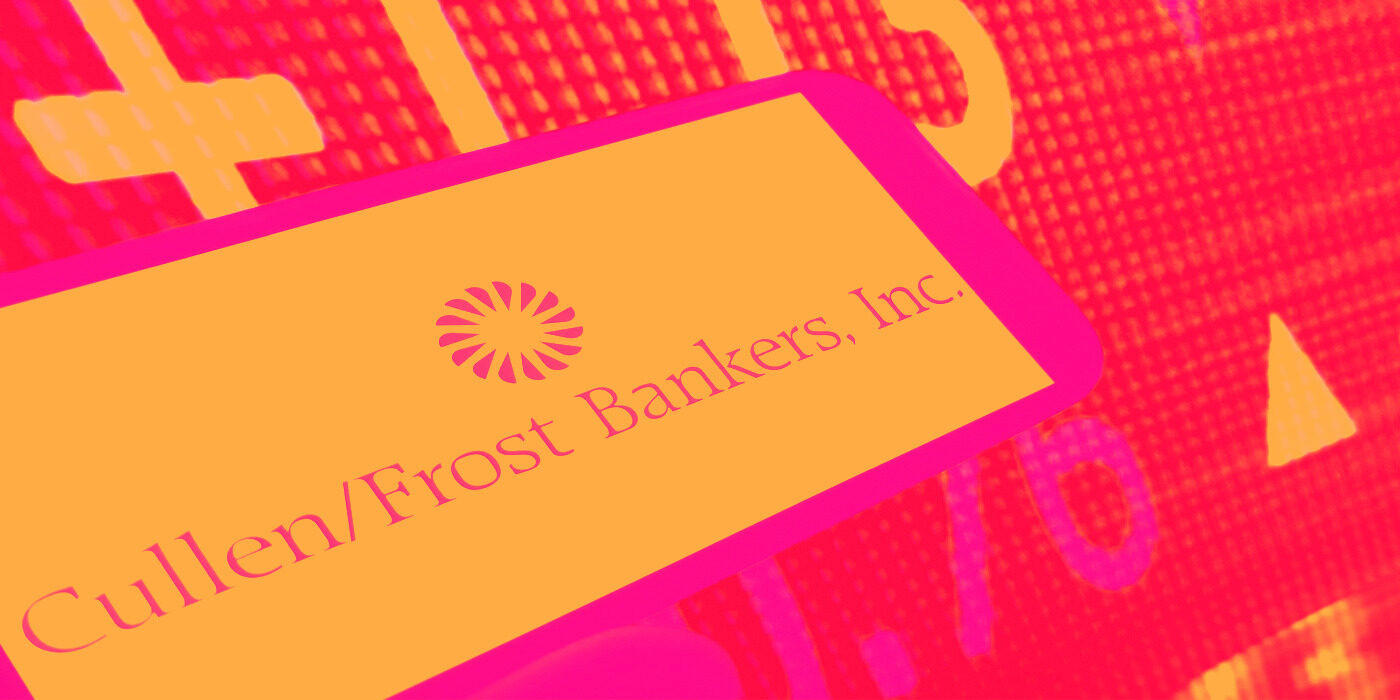
Texas-based financial institution Cullen/Frost Bankers (NYSE: CFR) reported Q2 CY2025 results exceeding the market’s revenue expectations, with sales up 7.7% year on year to $546.9 million. Its non-GAAP profit of $2.39 per share was 3.5% above analysts’ consensus estimates.
Is now the time to buy CFR? Find out in our full research report (it’s free).
Frost Bank (CFR) Q2 CY2025 Highlights:
- Revenue: $546.9 million vs analyst estimates of $543.9 million (7.7% year-on-year growth, 0.6% beat)
- Adjusted EPS: $2.39 vs analyst estimates of $2.31 (3.5% beat)
- Market Capitalization: $8.03 billion
StockStory’s Take
Frost Bank’s second quarter was marked by ongoing expansion efforts, robust loan and deposit growth, and intensified market competition. Despite exceeding Wall Street’s revenue and non-GAAP profit expectations, the market reacted negatively to the results. Management cited increased operating expenses tied to branch expansion and higher marketing spend as key factors that pressured margins. CEO Phil Green noted, “We continue to see solid results, and it's been driven by the hard work of our Frost Bankers and the extension of our organic growth strategy.” The quarter also saw strong consumer and real estate lending activity, but competitive pricing and structural pressures in commercial lending weighed on profitability.
Looking forward, Frost Bank’s guidance is anchored in expectations for mid to high single-digit loan growth, ongoing deposit gains, and a gradual ramp in profitability from its Texas expansion strategy. Management cautioned that while expense growth should moderate as branches mature, competitive dynamics in lending and deposit gathering could persist. CFO Dan Geddes emphasized, “We expect the overall [expansion] effort will be accretive to earnings in 2026,” but acknowledged near-term headwinds from upfront investments and evolving rate cut assumptions. The company’s focus remains on organic growth, with no plans for bank acquisitions, and management expects seasonal trends in deposits and disciplined cost control to drive future margin improvement.
Key Insights from Management’s Remarks
Management attributed the quarter’s mixed financial performance to continued investment in Texas market expansion, heightened competition in commercial lending, and a return to more traditional deposit growth trends.
- Branch expansion progress: Frost Bank opened its 200th location in Texas, with expansion markets like Houston, Dallas, and Austin now accounting for a substantial share of loan and deposit growth. Management highlighted that expansion branches contributed over one-third of total loan and deposit increases year-over-year, bringing in nearly 69,000 new households since launch.
- Commercial lending competition: The bank experienced increased competition, especially in commercial real estate lending. Management noted that losses due to competitive pricing decreased, but losses due to structure—such as more aggressive terms from rivals—rose to their second-highest level ever. CEO Phil Green stressed the importance of maintaining prudent underwriting standards despite industry pressure.
- Consumer deposit growth: Consumer deposits grew 3.7% year-over-year, with checking account balances returning to steady growth after a post-pandemic period in which customers favored certificates of deposit (CDs). Management pointed to a 5.4% increase in checking households, which they described as industry-leading.
- Loan and deposit mix shift: The quarter saw a continued shift in deposit mix, with higher-cost CDs and money market accounts making up a larger share, impacting net interest margin. CFO Dan Geddes explained that while net interest margin improved slightly, the benefit was offset by higher funding costs as customers sought better rates.
- Stable credit quality: Credit quality remained strong by historical standards, with nonperforming assets and net charge-offs at manageable levels. The uptick in problem loans was concentrated in multifamily properties, which management expects to resolve later this year. Other commercial real estate segments showed steady operating performance and acceptable risk metrics.
Drivers of Future Performance
Frost Bank expects loan and deposit growth, expense normalization, and disciplined lending to shape results in the coming quarters, while competitive and rate-related headwinds persist.
- Texas expansion payback: Management believes the maturation of new branches in Houston, Dallas, and Austin will drive earnings accretion beginning in 2026, as more locations move beyond the break-even stage. CEO Phil Green underscored the scalable nature of the expansion, expecting these efforts to fund future growth without needing acquisitions.
- Interest rate and deposit mix risk: Frost Bank’s outlook assumes two Federal Reserve rate cuts in the second half of the year. Shifts toward higher-cost deposits, such as CDs, could pressure net interest margin if rate cuts are delayed or deposit competition intensifies. CFO Dan Geddes pointed out that funding costs could rise further in a prolonged “higher for longer” rate environment.
- Expense control and efficiency: As more branches mature, management anticipates expense growth will moderate, reducing the drag on profitability. Dan Geddes said, “The rate of growth in expenses will be headed down over time,” with lower marginal investment required for additional expansion. However, continued spending on technology and marketing remains necessary for competitive positioning.
Catalysts in Upcoming Quarters
In the coming quarters, our team will focus on (1) tracking the pace at which new Texas branches reach profitability, (2) monitoring deposit mix shifts and their impact on net interest margin, and (3) assessing competitive pressures in commercial lending. Additionally, we will be watching for any changes in the timing or magnitude of Federal Reserve rate cuts and how those influence both funding costs and loan demand.
Frost Bank currently trades at $124.85, down from $134.22 just before the earnings. Is the company at an inflection point that warrants a buy or sell? Find out in our full research report (it’s free).
High Quality Stocks for All Market Conditions
Donald Trump’s April 2025 "Liberation Day" tariffs sent markets into a tailspin, but stocks have since rebounded strongly, proving that knee-jerk reactions often create the best buying opportunities.
The smart money is already positioning for the next leg up. Don’t miss out on the recovery - check out our Top 9 Market-Beating Stocks. This is a curated list of our High Quality stocks that have generated a market-beating return of 183% over the last five years (as of March 31st 2025).
Stocks that made our list in 2020 include now familiar names such as Nvidia (+1,545% between March 2020 and March 2025) as well as under-the-radar businesses like the once-micro-cap company Kadant (+351% five-year return). Find your next big winner with StockStory today.
StockStory is growing and hiring equity analyst and marketing roles. Are you a 0 to 1 builder passionate about the markets and AI? See the open roles here.





